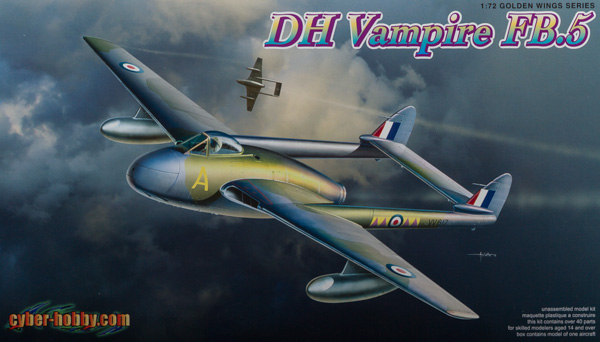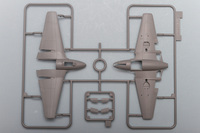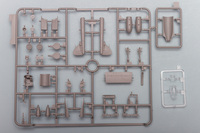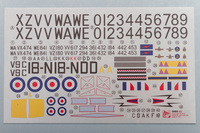
Cyber-Hobby 1/72 de Havilland Vampire FB.5
By Chris Banyai-Riepl
Overview
De Havilland developed the Vampire for the Royal Air Force during the Second World War, and it was the second RAF jet to enter service, behind the Gloster Meteor. While too late to see combat during the war, the Vampire saw extensive use both in the RAF and abroad, with some remaining in the training role well into the 1960s. Well over 3000 Vampires were built, and the design evolved into the de Havilland Venom and Sea Vampire.
The Kit
 For a long time, the only Vampire kit in 1/72 was the old Heller or Frog kit, both reboxed by several companies over the years. In recent years, though, we have seen some superb resin kits from CMR and some new-tool injection kits from Amodel. Now Cyber-hobby and Dragon have jumped into the Vampire world with this new release of a Vampire FB.5. Taking advantage of their slide mold technology, there are fewer parts than one might expect for a Vampire kit. There is a detailed cockpit, the expected recessed panel lines, and several decal options in the kit.
For a long time, the only Vampire kit in 1/72 was the old Heller or Frog kit, both reboxed by several companies over the years. In recent years, though, we have seen some superb resin kits from CMR and some new-tool injection kits from Amodel. Now Cyber-hobby and Dragon have jumped into the Vampire world with this new release of a Vampire FB.5. Taking advantage of their slide mold technology, there are fewer parts than one might expect for a Vampire kit. There is a detailed cockpit, the expected recessed panel lines, and several decal options in the kit.
Starting with the interior, this comes with a one-piece cockpit tub that gets a separate seat and control column added to it. There is some nice molded in detail in the tub, including various knobs and dials for the side console. Unfortunately, the entire cockpit bears little resemblance to a Vampire cockpit, and those interested in even a modicum of accuracy will have to replace the entire thing. Given how much information is out there on the Vampire, this complete departure from anything realistic is quite surprising.
 With the disappointment of the interior over with, the fuselage assembly comes next, and this assembly includes both the fuselage and wings. Split into upper and lower pieces, the fuselage/wing assembly also has some nicely done separate intake inserts, as well as a separate nose wheel bay. The instructions indicated to add some weight in the nose, a fact true of just about every Vampire kit. While all of this is a simplified assembly, there will be some extra work needed in finishing the fuselage, as the nose features extensive panel lines that are nonexistent on the real aircraft. Manufactured of plywood, there are actually very few seams found on the fuselage, especially the nose. This kit has quite a few panel lines on the nose, most of which are spurious.
With the disappointment of the interior over with, the fuselage assembly comes next, and this assembly includes both the fuselage and wings. Split into upper and lower pieces, the fuselage/wing assembly also has some nicely done separate intake inserts, as well as a separate nose wheel bay. The instructions indicated to add some weight in the nose, a fact true of just about every Vampire kit. While all of this is a simplified assembly, there will be some extra work needed in finishing the fuselage, as the nose features extensive panel lines that are nonexistent on the real aircraft. Manufactured of plywood, there are actually very few seams found on the fuselage, especially the nose. This kit has quite a few panel lines on the nose, most of which are spurious.
The remaining construction will go quite fast. The tail booms are molded as one piece, with a separate insert fitting into the wing. The horizontal stabilizer is also a single piece, while the upper rear fuselage is separate (I would expect to see a Vampire Mk II with the large intake scoops in the future, given the parts breakdown). Flipping the plane over, the landing gear is well detailed yet quite sturdy. The kit also comes with wing fuel tanks.
 The decal choices are extensive in this kit, and perhaps make up for some of the other deficiencies of the kit. There are five silver options and six camouflaged options. The general markings and schemes are similar, so the only real changes across all these schemes are found in the serials and squadron markings. For the silver options (which are painted aluminum, not natural metal), the units covered are 502 Squadron RAuxAF, 202 Advanced Flying School, 185 Squadron RAF, 16 Squadron RAF, and 603 Squadron RAuxAF. The camouflaged options include 603 Squadron RAuxAF, 602 Squadron RAuxAF, 605 Squadron RAuxAF, 607 Squadron RAuxAF, 118 Squadron RAF, and 98 Squadron RAF.
The decal choices are extensive in this kit, and perhaps make up for some of the other deficiencies of the kit. There are five silver options and six camouflaged options. The general markings and schemes are similar, so the only real changes across all these schemes are found in the serials and squadron markings. For the silver options (which are painted aluminum, not natural metal), the units covered are 502 Squadron RAuxAF, 202 Advanced Flying School, 185 Squadron RAF, 16 Squadron RAF, and 603 Squadron RAuxAF. The camouflaged options include 603 Squadron RAuxAF, 602 Squadron RAuxAF, 605 Squadron RAuxAF, 607 Squadron RAuxAF, 118 Squadron RAF, and 98 Squadron RAF.
Conclusion
While this kit does have some issues, it does look like it will build up nicely, and given the great number of Vampire schemes out there, one can never have too many Vampire kits. Still, for those looking for an accurate out of box Vampire, the new Airfix kit might be the better route to go. My thanks to Dragon USA for the review sample.
